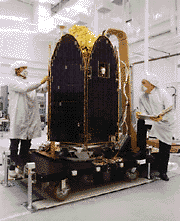TOMS-EP
Total Ozone Mapping Spectrometer - Earth Probe
 TOMS-EP is the third mission in NASA's TOMS program, which provides long-term observations of the global distribution of the Earth's ozone layer and measurements of sulfur-dioxide released in volcanic eruptions. Previous versions of the spacecraft's TOMS instrument were launched aboard the Nimbus-7 (1978) and Soviet Meteor-3 (1991) satellites. These instruments provided detailed maps of the world's global atmospheric ozone distribution, and observed the Antarctic "ozone hole" which forms September through November of each year. TOMS-EP will add to the data set collected by these missions, and will be followed by other TOMS instruments carried aboard the ADEOS (1996) and Russian Meteor-3M satellite (2000). Originally intended for launch in 1994, TOMS-EP was delayed by the failures of the first two Pegasus XL launch vehicles. As a result of this delay, TOMS-EP will now fly simultaneously with the ADEOS TOMS instrument (originally planned as TOMS-EP's successor). To prevent the gathering of redundant data sets, TOMS-EP was placed into an orbit lower than origianlly planned to obtain higher resolution measurements. The two instruments working at different altitudes will enhance data collection by affording a more reliable separation of stratospheric ozone from tropospheric ozone, improving detection of urban pollution and other
small-scale features, and allowing comparison of ozone data from cloudy and clear atmospheres. Together, TOMS-EP and ADEOS will provide full daily global coverage of ozone measurements. The TOMS program is part of NASA's Mission to Planet Earth, a long term, coordinated research
effort to study the Earth as a global environmental system.
TOMS-EP is the third mission in NASA's TOMS program, which provides long-term observations of the global distribution of the Earth's ozone layer and measurements of sulfur-dioxide released in volcanic eruptions. Previous versions of the spacecraft's TOMS instrument were launched aboard the Nimbus-7 (1978) and Soviet Meteor-3 (1991) satellites. These instruments provided detailed maps of the world's global atmospheric ozone distribution, and observed the Antarctic "ozone hole" which forms September through November of each year. TOMS-EP will add to the data set collected by these missions, and will be followed by other TOMS instruments carried aboard the ADEOS (1996) and Russian Meteor-3M satellite (2000). Originally intended for launch in 1994, TOMS-EP was delayed by the failures of the first two Pegasus XL launch vehicles. As a result of this delay, TOMS-EP will now fly simultaneously with the ADEOS TOMS instrument (originally planned as TOMS-EP's successor). To prevent the gathering of redundant data sets, TOMS-EP was placed into an orbit lower than origianlly planned to obtain higher resolution measurements. The two instruments working at different altitudes will enhance data collection by affording a more reliable separation of stratospheric ozone from tropospheric ozone, improving detection of urban pollution and other
small-scale features, and allowing comparison of ozone data from cloudy and clear atmospheres. Together, TOMS-EP and ADEOS will provide full daily global coverage of ozone measurements. The TOMS program is part of NASA's Mission to Planet Earth, a long term, coordinated research
effort to study the Earth as a global environmental system.
Spacecraft
Based on the TRW Eagle family of light weight spacecraft. 3-Axis stabilized with pointing control to 0.5 deg (3-sigma) in pitch/roll, 1 deg in yaw and knowledge to 0.25 deg (3-sigma). Two solar arrays provide up to 275W. Hydrazine propulsion system (54 kg fuel) with eight thrusters (0.4 and
1 lbf) is used to raise the orbit and desaturate momentum wheels. Communications via DSN, GSTDN. Downlink rate: 50 and 202 kbps. Uplink rate: 2 kbps. 16 Mb solid state storage.
Designed for 24 hour autonomous operation.
Payload
The TOMS instrument has a mass of 35 kg and 25 watts average power. Resolution is 47 km at nadir and 62 km average. Swath width is 2750 km. TOMS/EP measures total ozone by observing both incoming solar energy and backscattered ultraviolet (UV) radiation at six wavelengths.
"Backscattered" radiation is solar radiation that has penetrated to the Earth's lower atmosphere and is then scattered by air molecules and clouds back through the stratosphere to the satellite sensors. TOMS makes 35 measurements every 8 seconds, each covering 30 to 125 miles (50 to 200
kilometers) wide on the ground, strung along a line perpendicular to the motion of the satellite.
| Country of Origin | United States |
| Customer/User | NASA, GSFC |
| Manufacturer(s) | TRW, Perkin Elmer |
| Size | 1.1 m diameter x 1.73 m tall (stowed), solar panels 3.9 m across when deployed |
| Orbit | 500 km, circular, sun-synchronous, incl. = 97.36 deg. Originally planned for 955 km, circular, sun synchronous |
| Design Life | 2 years |
| Related Sites | NASA TOMS Homepage |
Launch Facts
| Name | Int'l Desig. | Date | Site | Vehicle | Orbit | Mass(kg) |
| Notes | ||||||
| TOMS-EP | 1996-037A | 7/2/96 | WSMC | Pegasus XL | LEO | 248 |
| Total Ozone Mapping Spectrometer-Earth Probe; atmospheric ozone mapping | ||||||
Information in The Mission and Spacecraft Library is provided without warranty or guarantee. USE AT YOUR OWN RISK.